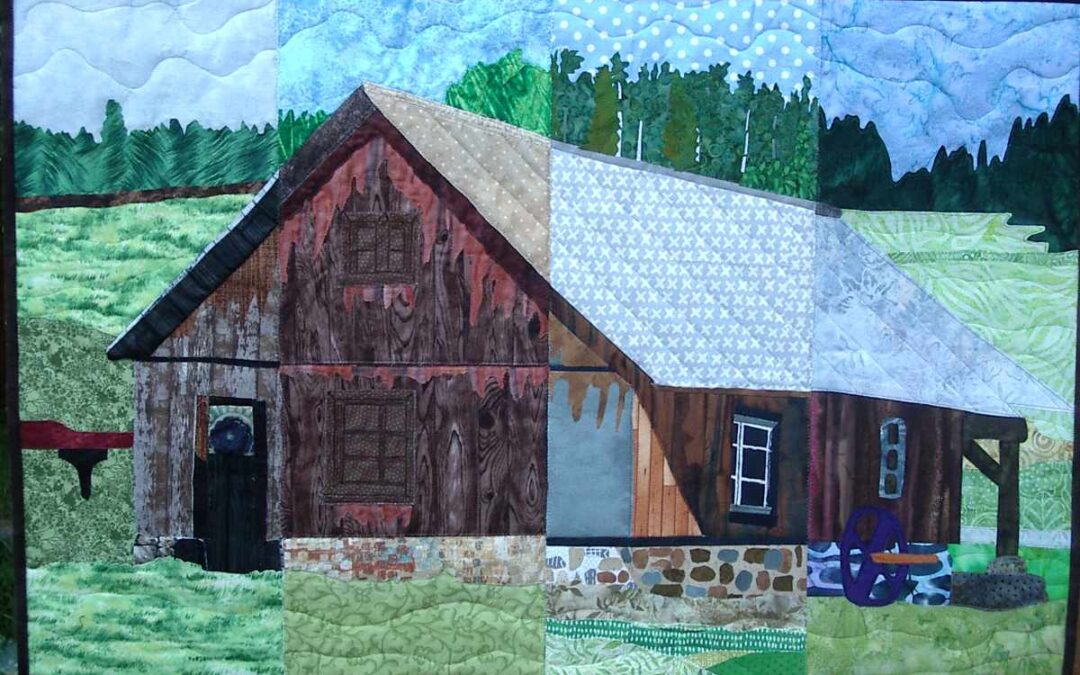This Barn Quilt was created during a group slice quilt project by the Stray Threads Quilt Guild, 2019 – 2020. The panels, left to right, were made by Jill Green, Linda Lunt, Pat Peterson and Leslie Henderson.
“What is an Art Quilt?’ really asks three questions:
What is a Quilt?
What is Art?
How do Quilts and Art intersect?
I hold no ranking or value judgement among the various types of quilts. Every quilt is a wonderful and special form of creative expression. Expertise of construction, use of design principals, choices of color and fabrics are all elements of a quilt, not a defining statement of its worth or value. A fine example is the quilts of Gee’s Bend and their 2002 exhibition at the Houston Museum of Fine Arts. (https://en.wikipedia.org/wiki/Quilts_of_Gee’s_Bend)
A generally accepted, tangible definition of a quilt is two or more layers of fabric and one or more layers of batting, all of which are held together by thread stitches. Within that very loose definition we include yarn for tying, various types of fibers for fabric, natural and manufactured strands for couching, ribbon and beads and buttons for embellishment, etc.
The definition of art is less clear and more subjective. ThoughtCo says “There is no one universal definition of visual art though there is a general consensus that art is the conscious creation of something beautiful or meaningful using skill and imagination.” (https://www.thoughtco.com/what-is-the-definition-of-art-182707). For me, visual art attempts to reveal truth, convey a message, evoke a response, express an emotional feeling. It is an effort, intentional or unconscious, to share some part of the artist’s inner landscape with the outside world.
Where Art and Quilts intersect, all manner of wild, unique conditions can exist. In really edgy art quilts, “Batting” can include almost anything: old wool blankets, corn husks, modern plush fleece, resin bonded polyester, lightweight Peltex, feathers, down etc. “Fabric” can be thin, flexible woven grass mats, vinyl shower curtains https://www.contemporaryquiltart.com/Archives/artquiltsridge/Dukay_PlasticSurgeon.htm), tulle and netting, flexible wire mesh stitched to a backing, lace panels etc. “Thread” can include fine gauge string, narrow ribbon, natural fibers such as wool, cotton, silk, bamboo twisted into a cord, monofilament and metallic thread, glue.
Unconventional construction techniques, experimentation, pushing the boundaries, intentionally breaking the “rules,” beading, and surface design techniques tend to be more common in art quilts than in other types of quilts. Art quilts are usually meant to be displayed rather than functionally used. Taking advantage of that intended use, art quilts may have irregular shapes, significant surface dimensions and elaborate embellishment.
Think of two clouds in the sky, a big fluffy white one and a dark gray storm cloud. When those clouds collide, the part where they overlap will not be bright white nor will it be dark gray either, it will be somewhere in between. The edges of the overlap will be kind of fuzzy, not a sharp clean line. An Art Quilt is like that. It can be defined as an entity on a spectrum from pure quilt to pure art.
These art quilters illustrate that “in between” spectrum condition:
Irene Roderick’s quilts are way over the line towards abstract art.
https://www.ireneroderick.com/
M. Joan Lintault’s quilts are on the far end of the spectrum towards art also.
https://www.mjlintault.art/html/gallery_pages/gallery.htm
Ana Sumner’s quilts look more like quilts but are still on the art end of the spectrum. https://sewuniqueart.com/gallery-2/
Velda Newman’s quilts look a little less like art, a little more like quilts. http://www.veldanewman.com/portfolio.html
Jo Budd’s quilts with their geometric shaped pieces are towards the quilt end of the spectrum.
http://www.jobudd.com/ and https://duckduckgo.com/?q=jo+budd+quilt&t=h_&iax=images&ia=images
Ann Harwell’s quilts are on the quilt end of the spectrum.

